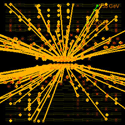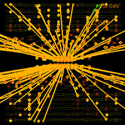Background checking at LHC
The Large Hadron Collider (LHC) at CERN has begun to months of running at a - center-of-mass energy—more than three times that achieved at the Fermilab collider. Before they can start to look for signals of new physics, however, the four LHC experiments, ATLAS, CMS, ALICE, and LHCb, must understand the huge spectrum of background events.
Using data from the first hour of - operations, the CMS collaboration, which stands for “Compact Muon Solenoid” and consists of more than authors from institutions in countries, extracted information about the multiplicity of background events as a function of a (logarithmic) measure of the particle emission angle called “pseudorapidity.” They found a large increase in the number of charged particles per unit pseudorapidity compared with what has been seen at lower energies. The discrepancy exceeds that predicted by established event simulation models, indicating the parameters in these models will need to be tuned to be accurate for such high-energy collisions.
And so begins the dawn of exploration of a new energy frontier at the LHC. – Robert Garisto





